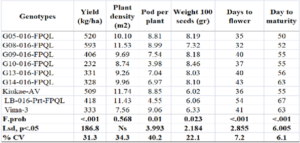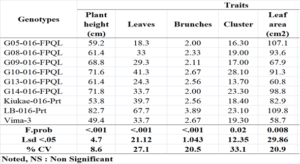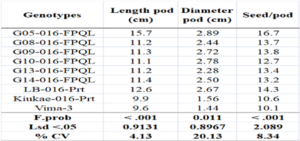Publication Information
Frequency: Continuous
Format: PDF and HTML
Versions: Online (Open Access)
Year first Published: 2019
Language: English
| Journal Menu |
| Editorial Board |
| Reviewer Board |
| Articles |
| Open Access |
| Special Issue Proposals |
| Guidelines for Authors |
| Guidelines for Editors |
| Guidelines for Reviewers |
| Membership |
| Fee and Guidelines |
 |
Combining Short Duration and Adaption of Timorese Mungbean Land Races (Vigna radiata, L.)
Inácio Savio Pereira1*, Deolindo de Oliveira2, Armandina Marçal2, Luis Pereira3, Robert L. Williams3
1Ministry of Agriculture, Livestock, Fishery, and Forestries (MALFF), Timor-Leste – 2024
2National Directorate of Research and Statistic (NDRS)
3Research Department of Criation and Production (RDCP)
Received Date: May 12, 2024; Accepted Date: June 10, 2024; Published Date: July 05, 2024;
*Corresponding author: Inácio Savio Pereira, Ministry of Agriculture, Livestock, Fishery, and Forestries (MALFF), Timor-Leste – 2024, Email: inacio.soltimor@gmail.com
Citation: Pereira IS, Oliveira DD, Pereira L, Williams RL (2024) Combining Short Duration and Adaption of Timorese Mungbean Land Races (Vigna radiata, L.). Adv Agri Horti and Ento: AAHE-207
DOI: 10.37722/AAHAE.2024402
Abstract
Mung bean varieties in Timor-Leste are dominated by local land races and two recently tested and released short-season. The short season varieties, Kiukae-AV and Lakateu, were previously released as Delta and Merpati in Indonesia and Australia respectively. Land races typically flower and mature one month later than the shorter season varieties. A breeding program has commenced with the objective of combining the high production, drought tolerance and resistant of pests and diseases in land races with shorter duration of modern varieties. A selection of 4 land races was made from a collection of 42 land races as potential parents. In 2016, the initial crosses were made between Kiukae-AV and Local BOB Viqueque. In 2020, more crosses involving 4 land races were made. Two F7 lines, G05-016-FPQL and G08-016-FPQL were identified as flowering earlier than the parents, shiny seed coat and consistent higher yield above the parents.G08-016-FPQL produced at least 15% more than the average parent yield.
Keyword: Short Duration, Adaptation, Land Races, Mungbean (Vigna radiata, L.)
Background
Timor-Leste is a one of the potential in agricultural and has staple several food crops, thought out the fewer yields per year. Timor-Leste Government by the Ministry of Agriculture, Livestock, Fishery, and Forestry (MALFF) would not focus yet on crop breeding specific in mungbean plants. Plant genetic and breeding is most important in Timor-Leste and would be increase mungbean productions, related human resources of acknowledgement, now will be improving in breeding methods and techniques to increase mungbean yield and genetic improvements. MALFF National released mungbean new variety candidate with yield 1.3 t/ha (Kiukae-AV), 2016, (MAF-DNPEIG-SoL, 2015). It is most important pulse crop in Timor-Leste as well for food basket (Cesta Basica) in 2021-2022.
Timor-Leste is a potential in beans, specific on mungbean, have a 1.3 million people, according to Census agriculture 2019, populations have 66% worked in agricultural (Data statistics, 2019). Mungbean yields per year only 1.0 - 1.3 ton/ha compared to other country, (Win et al, 2020), it’s less new technology and technician in breeding program. Traditional system in cultivation of accessions as modern variety improvement on mungbean traits experiments in conventional breeding for hand pollination by the hybridization activity, respectively, (Ramakrishnan Nair, 2019). The productivity of mungbean in Timor-Leste still low yields compared other advanced countries; each year producing 1 ton/ha – 2 ton/ha than other country starting from 2.1 ton/ha above and have 50% own awareness to the production of mungbean, so each year the productivity is poor from 2 ton/ha, (Andy Soegianto and Kuswanto, 2013). Breeder created new genotypes to further promote and improve the mungbean production in Timor-Leste by creating hybridization of conventional breeding between the traits of parent lines to become candidate for new varieties in future as well in selective breeding.
The systematic breeding and the extensive cultivation of mungbean using traditional systems has led to the misconception that mungbean is a low-yielding crop. With the development and release of a series of breeding lines with an erect growth habit and high yields, mungbean production has increased significantly in recent decades, (Kim et al, 2004, 36).
A new preliminary test for genotypes from the hybridization selection result was a finally phase of breeding program, (Ramakrishnan Nair, 2019). Where selected for the pure line superior and produced as homozygote. Mungbean breeding is the planned and controlled hybridization between diverse, selected genotypes to create new or more desirable combinations among the existing genes, (Poespodarsono, 1988).
The genetic variation of mungbean through the germplasm is high, there is high chance that new superior varieties will be created, according to the wishes of Breeder, as well as being able to adapt to the growing environment (Indriani dkk, 2008 into Nurais, dkk, 2021). Those accessions of collection on mungbean in Timor-Leste can do the plan collection date and conserving, recorded the land races history, field book of data list (Pedigrees), cultivating and selecting accessions traits by Breeder, selection is a method during breeding is ongoing in the field, and selection does in year-1 to year-6, then continue in breeding for crossing plan, (Ebert, 2015).
Mungbean accession and breeding in the field
Selection land races in the field improved by Breeder incorporate phenotypic and genotypic identity markers into their accessions traits of design selective and as moderately in on farm traits experiment as possible collection for genetic materials in breeding program in Timor-Leste in particularly. Cultivation local variety needed planting per accession and labelling of marker selection in season time, respectively. Forty two accessions were selected four land races based on agronomic traits suitable for the south coast, such as days to flowering, drought tolerance, seed weight, and seed color from the results of 4 years screening of approximately 42 accessions in Timor-Leste, (Ebert, 2013). These land races were made selection in Timor-Leste with typically traits per year and got homozygote for breeding program.
Objectives
Identify high production of new lines, drought tolerance, resistant to pests and diseases and land races with shorter duration of modern varieties.
Materials and Methods
The materials were used in breeding program is mungbean accessions together 42 land races varieties. New genotypes are 4 lines of hybridization results. And 4 land races selected as parent lines. This research was conducted with augmented design in spatial for selection activities and randomized completely block design (RCBD). The initial crosses in 2016 such two-parent lines are Kiukae-AV and Local BOB Viqueque. The ten genotypes consisted of 6 lines selected from F8 lines such as: G05-016-FPQL, G08-016-FPQL, G09-016-FPQL, G10-016-FPQL, G13-016-FPQL and G14-016-FPQL and two of the parent lines (Lokal BOB Viqueque and Kiukae-AV) and Vima-3 as controls were used in this research. Character unique of parent lines such as Kiukae-AV and Local BOB Viqueque are Kiukae-AV (Early to flower, short duration to harvest, high grain yield, and seed coat shiny) and Local BOB Viqueque (Long pod, big grains, drought tolerant and resistant to pests and diseases). Research used randomized complete block design of the 10 lines and three full replicates. The mean data were subjected to statistical analysis by ANOVA and LSD, p<0.05 levels.
Result and Discussion
Based on analysis of variation showed genotypes were obtained significant impact on yield, and yield components, except did not significant on plant density (Table Error! Reference source not found.).
Table 1: Yield and yield components on new genotypes

Table 1. Average values obtained for various characteristics measured in parental and new genotypes for hybrids on yield and yield components.
Genotypes were conducted trials and showed in yield of mungbean that all components have significant differences by analysis of variation with lsd, p<.05. Excepted plant density (cm2) was not significant different. G08-016-FPQL produced at least 15% more than the average parent yield, (Ulfa and Diana Maria, 2017). A yield of new genotype expressed a good performance in production on mungbean as result of hybridizations. The analysis of variation (ANOVA) showed the result of frequency table by the indicator p<, 0.05 that new genotype G08-016-FPQL did not significant with the G09-016-FPQL, G05-016-FPQL and Local BOB (LB-016-Prt-FPQL), but between them have difference significant with other genotypes on yield (kg/ha). Performances of new genotypes such as G05-016-FPQL, G08-016-FPQL is early flowering and maturity pods compared other included Kiukae-AV as parental line in hand pollination, during selective breeding ongoing as part of agronomic trials in Timor-Leste.
Quantitative character of Morphology in Vegetative Phase
Analysis variation showed significance different in trial by the genotypes influences on plant height, leaves, branches, and cluster and leaf area.
Table 2: All character of morphology observed in harvesting date

Evaluation of genotype on quantitative traits for some characters of morphology were evaluated by the observation after harvested. All traits have significance by the genotype trials on four of morphology characters are differences test by least significance different at p<.05. These characters evaluated are plant height, leaves, branches, clusters and leaf area.
Traits such as plant height (cm), leaves, branches, cluster and leaf area (cm2) were significant influenced by genotypes. A plant height measured was gotten the higher plant in Local BOB (LB-016-FPQL) with value 82.7cm then a short plant height was in Vima-3 (49.4cm).
A new character of many leaves was in Local BOB (LB-016-FPQL) with value 67.7 then a little bit leaves were in G05-016-FPQL with value 18.3. The trait have many branches and clusters were in (G10-016-FPQL and LB-016-Prt) with value 28.1 and 3.89 then a little bit branches and clusters were in G13-016-FPQL and G05-016-FPQL with value 13.70 and 2.00. It is necessary to find more crops from the wild species that may have potential as new food crops. The wild species can also serve as germplasm for the improvement of productivity of our present agricultural crops through conventional breeding in particular significance are the economic benefits of plants for food security and environmental stability, (Ebert, 2013).
Character Quantitative Morphology in Generative Phase
Table 3: All character of morphologies observed in harvesting time

Three characters of quantitative have observed and evaluated on generative traits phase in mungbean morphology as agronomic components. Evaluated had done on mungbean traits such length pod, pod diameter and seed per pod have significance different by the ANOVA analysis showed in probability. From three characters, a higher result is G05-016-FPQL compared to other traits.
The length pods measured showed the maximum length pod is in genotype G05-016-FPQL (15.7cm), it is a good performance in plant; and shorter pod is in Vima-3 (9.6cm).
Diameter pod is a trait and measured to know good quality pods were produced in environment and genetic improvement, linkages for another traits influenced by the genotypes. Genotype in code with G05-016-FPQL produced diameter pods 2.89cm as a higher compared with Vima-3 1.44cm as lower.
A many seeds per pod showed in G05-016-FPQL, its grains 16.7 were a higher result than Vima-3 produced 10.1 seeds; The G05-016-FPQL was significant different compared to other genotypes. Weight seeds per pod were significant different and influenced by genotypes in this experiment in all seasons.
Conclusion
Two F7 lines such G05-016-FPQL and G08-016-FPQL were identified as flower earlier than the parents. Shiny seed coats and consistent higher yield above the parents. Genotype G08-016-FPQL produced at least 15% more than the average parent yield.
Reference
- Andy Soegianto, Kuswanto, 2013. Uji Daya Hasil Pendahuluan Galur Harapan Tanaman Kacang Panjang (Vigna sesquipedalis L. Fruwirth) Berpolong Ungu Preliminary Yield Trials On Potential Lines Of Purple Yard Long Bean (Vigna sesquipedalis L. Fruwirth) CicikSepteningsih*). Jurusan Budidaya Pertanian Fakultas Pertanian, Universitas Brawijaya Jl. Veteran, Malang 65145, Jawa Timur Indonesia E-mail: kuswantoas@gmail.com. JURNAL PRODUKSI TANAMAN Vol. 1 No. 4 SEPTEMBER-2013 ISSN: 2338-3976.
- Ebert AW, 2013. Ex situ conservation of plant genetic resources 1 of major vegetables. In: Normah MN, Chin HF, Reed BM, editors. Conservation of tropical plant species. New York: Springer Science Business Media; 2013. p. 373–417.
- Kim, D.K.; Lee, Y.S.; Lee, J.Y.; Bak, G.C.; Bang, G.P.; Park, I.J.; Moon, J.K.; Oh, Y.J.; Min K.S. A new high-yielding mungbean cultivar, “Soseon” suitable for sprout with small seed. Korean J. Breed. 2004. 36, 383–384. [Google Scholar].
- MAF-DNPEIG-SoL, 2015. Mungbean an adaptability test of introduced variety in Timor- Leste
- Nurain S. Tahir, Indriati Husain, Sutrisno Hadi Purnomo,2017.UjiPendahuluanDaya Ha Satu Genotipe Lokal (Landrace) Dengan Tiga Varietas Pembanding Kacang Hijau (Vigna radiata L) Di Gorontalo. A PreliminaryTest of the Yield of One LocaGenotype (Landrace) with Three Comparative Varieties of Mung Beans (Vignaradiate L) in Gorontalo, Mahasiswa Program Studi Agroteknologi Fakultas Pertanian Universitas Negeri Gorontalo. Staf Pengajar Program StudiAgroteknologiFakultasPertanianUneversitasNegeri Gorontalo Jln. Jend. Sudirman No. 6 Kota Gorontalo 96128 Correspondenceauthor indriati.husain@ung.ac.id.
- Poespodarsono, S. 1988. Dasar-Dasar Ilmu Pemuliaan Tanaman. Pusat Antar Universitas Institut Pertanian Bogor. Bogor.
- Ramakrishnan Nair, 2019. Biotic and Abiotic Constraints in Mungbean Production Progress in Genetic Improvement Article in Frontiers in Plant Science· World Vegetable Center October 2019 DOI: 10.3389/fpls.2019.01340. Stats, and author profiles for this publication at: https://www.researchgate.net/publication/336814209. 02-22.
- Roland Schafleitner1, Ramakrishnan Madhavan Nair2, Abhishek Rathore3, Yen-wei Wang1 Chen-yu Lin1, Shu-hui Chu1, Pin-yun Lin1, Jian-Cheng Chang1 and Andreas W Ebert1.2015. The AVRDC – The World Vegetable Center mungbean (Vigna radiate L.) core and mini core collections. Research Article.
- Ulfa, Diana Maria (2017). Uji Daya Hasil 20 Galur Kacang Hijau (Vigna radiate L.). Sarjana thesis, Universitas Brawijaya. JATT Vol. 10 No. 2 Desember 2021 : 34 - 42 ISSN 2252-3774, 34.
- Win, K.S., Win, S., Htun, T.M. and Win, N.K.K. (2020). Characterization and Evaluation of Mungbean [Vigna radiata (L.) Wilczek] Germplasm through Morphological and Agronomic Characters. Indian Journal of Agricultural Research. 54(3): 308-314. Submitted: 24-12-2019 Accepted: 24-01-2020. Published: 15-05-2020.